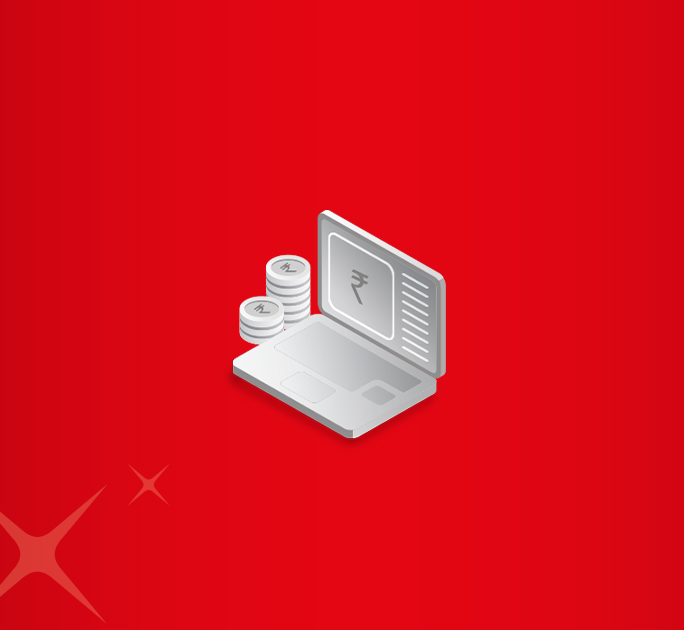- Save
- Invest
- Borrow
- Pay
- More
- Customer Services
Goods And Service Tax Payment
all other indirect tax forms in India.
Goods And Service Tax Payment
The GST Tax is a single tax that has replaced all other indirect tax forms in India.
The Goods and Service Tax simply referred to as the GST in India, is a uniform, indirect tax introduced by the Government of India in March 2017. It came into effect on July 1, 2017. The GST was introduced to replace most other indirect taxes in India, such as the VAT, service tax, excise duty, and so on.
The Government of India levies the GST tax on the supply of all kinds of products you can purchase and services you can avail of in the Indian public and private domains. It is essentially a multi-stage, comprehensive, destination-based tax levied on value-added services.
How does GST work?
With the introduction of the Goods & Service Tax, the Government of India replaced the previous indirect tax regime and introduced a single tax. Under GST, every state follows the same tax rate for a particular product purchased or service availed. The tax rate is determined by the Central Government and helps make the tax administration easy. Now, instead of paying taxes at multiple stages in the supply chain, Indian taxpayers can pay a one-time GST at the end of the supply chain.
GST Components
The Goods & Service Tax comprises of three taxes now subsumed or absorbed by the Government under one umbrella. These include:
- The CGST or the tax collected by the Indian Central Government on intra-state sales, for instance, a transaction is occurring within Maharashtra borders.
- The SGST or the tax collected by each Indian State Government on intra-state sales, for instance, a transaction is occurring within Maharashtra borders.
- The IGST or the tax collected by the Indian State Government on an inter-state sale, for instance, a transaction occurring in Maharashtra to Karnataka.
With the new regime of GST, the Centre and States share the revenue equally on sales with the state. As for inter-state sales, the Government now levies only one type of tax, the central tax. The Centre then shares the IGST revenue, depending on the destination of goods.
How to Pay Goods and Service Tax?
- Login to your GST
- Select the ‘Pay Tax’ tab on the dashboard or navigate directly to Services > Payment and Create Challan.
- Select NEFT/RTGS as your preferred mode of payment and choose DBS bank from the drop-down menu featuring bank names and Click on Generate Challan.
- The Challan will be generated successfully. Review the beneficiary details such as their name, Bank account name and account number, IFSC code, and the amount mentioned in the Challan.
- Proceed to initiate the NEFT/RTGS Payment on DBS IDEAL. You can make the payment in the same way as you would a regular NEFT or RTGS payment.
GST Payment – Steps to Follow on DBS IDEAL
- Login to DBS IDEAL.
- Click on Payments and select NEFT.
- Select the debit account, customer reference (CPIN) for reconciliation and enter the amount as per Challan.
- Select the payment date and click on Create ‘New Beneficiary’.
- Provide beneficiary details as per your Challan along with an email for confirmation of processing by the bank.
- Enter the remaining details, click on ‘Submit Payment’ and proceed for approval.
- You can now approve the payment on the IDEAL 3.0 website or the IDEAL mobile app.
- Your account will be debited, and the payment will be sent to the beneficiary.
You will receive a confirmation SMS alert, and you can also check your account statement. You may refer to the transaction reference or UTR to track and update your payments. Also, ensure that you verify if the GSTIN payment details are correct. Note that you will also receive an email stating that the Goods and Service Tax has been paid on your registered email id, while the deposit status of Challan on the GST website will be updated as paid. You may now download the tax payment receipt from the GST website.
Do More, Live More
Open Instant DBS Bank Savings Account in just a few minutes.
Download digibank.
Fill your details and complete KYC.
Activate your DBS Bank savings account.
Frequently Asked Questions
The GST rate levied depends on the type of service purchased. The basic tax rate is anywhere from 5- 12 per cent, whereas the tax on luxury purchases and leisure services can be in the 18- 28 per cent range.
The Goods and Service Tax is a game-changer in that it has led to the creation of a uniform indirect tax payment channel. Besides bringing uniformity to indirect tax payment, the GST has also helped the Government curb tax evasion on the part of taxpayers, increasing the taxpayer base and improving the logistics and distribution systems in the country.
GST has helped remove the cascading effect of multiple taxes at different stages in the supply chain. It has redefined the treatment of e-commerce activities in India and helped regulate the unorganised sectors.
Our Products
- Savings Account
- Personal Loan
- Fixed Deposit
- Recurring Deposit
- Remittance
- Mutual Fund
- SIP
- Debit Card
- Bill Payment
- Internet Banking
- Travel Now
- PRIME Savings Account
- Safe Deposit Locker
Need Help?
- Calling from India:
1860 210 3456 / 1860 267 4567 - Calling from Overseas:
+91 44 6685 4555 - Help & Support
- Grievance Redressal
- Get in Touch with Us
Interest Rates & Calculators
- FD Interest Rates
- RD Interest Rates
- Personal Loan Interest Rates
- Savings Account Interest Rates
- Savings Account Interest Calculator
- FD Calculator
- RD Calculator
- Mutual Fund Calculator
- EMI Calculator
- SIP Calculator
- Lumpsum Calculator
- Financial Goal Calculator
- Monthly Investment Calculator
- ELSS Calculator
- Personal Loan EMI Calculator
Open Instant DBS Bank Savings Account
Useful Links
- About DBS
- Rates & Fees
- In the News
- Forms & Legal
- Grievance Redressal
- Anti-Malware Security Features
- Cyber Security
- Savings Schedule of Benefits
- Schedule of Charges
- KYC FAQs
- DBS Mobile Checksum
- Sitemap
- List of Recovery Agency
- List of Repossessed Properties
- Financial Inclusion
- Digital Lending Partnership CRED
- Co-lending partnership HCIN






